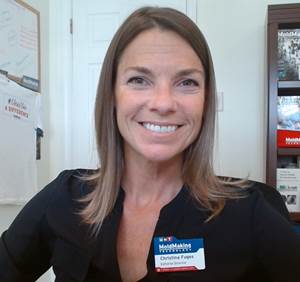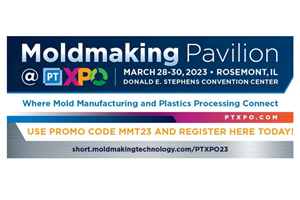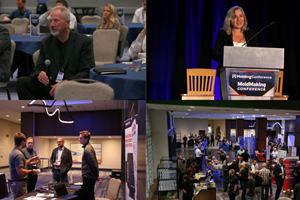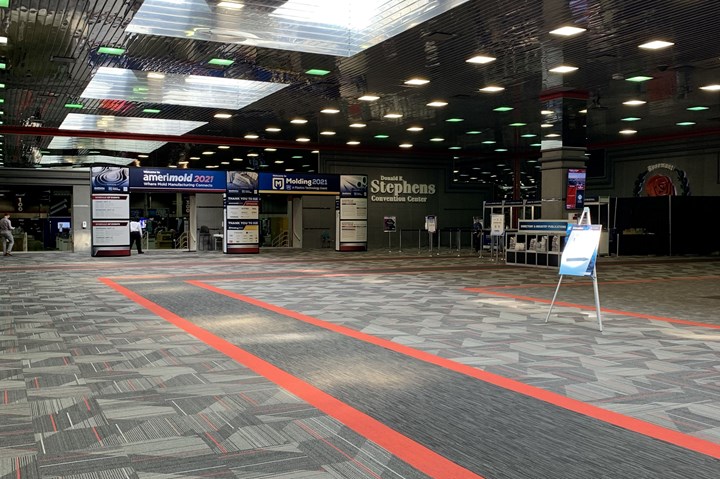
The day before the opening of Amerimold. Photo Credit, all images: MMT
Amerimold 2021 was an event to remember for several reasons. Not only was it the first time in almost two years that the industry came back together under one roof, it was also the first time we, the editors of MMT, were finally able to meet in person!
Whether it was our first time at a trade show, or the accumulation of many, each of us took away different experiences, lessons learned and much more, which we have shared with you in the Q&A below.
How do you see education, or the focus on education changing in the moldmaking industry?
Christina Fuges, Editorial Director, MoldMaking Technology: First, a mold is a machine. A mold is a highly engineered manufacturing system. So, the future of moldmaking is in advanced technologies that take the mold to the next level such as data collection and management, AI, machine learning (ML), additive manufacturing (AM), materials development, etc. There will be a heavy focus on engineering both the part and mold. However, a focus on the fundamentals of moldmaking in a more hands-on approach is essential moving forward to teach the basic skills needed to grow this next generation into skilled moldmaking professionals.
Lastly, COVID-19 also showed everyone how to educate and learn “virtually” so I see a hybrid approach taking shape. Traditional trade shows and conferences will come back but they will most likely be some sort of digital/virtual companion.
Grace Nehls, Assistant Print Editor, MoldMaking Technology: From what MMT has been covering over the last year, and from some of the discussions I had at Amerimold, emphasis on education, such as mentorships, growing young professionals entering the workforce and embracing the unconventional has been steadily growing. MMT’s 30 under 30 honorees announced this year are a prime example that the next generation is here—now, it comes down to finding ways to recruit them.
In what ways, if any, are companies attempting to cultivate and/or expand their next-gen workforce?
The general consensus to this question was that workforce diversity is being redefined through companies visiting/reaching out to local high schools and colleges, performing non-profit work or offering various programs or apprenticeships to find students who want to get their hands dirty.
Christina also mentioned the industry is looking more closely into untapped resources—meaning people they might not have considered before such as individuals with physical, developmental and emotional challenges or people who are unemployed or underemployed.
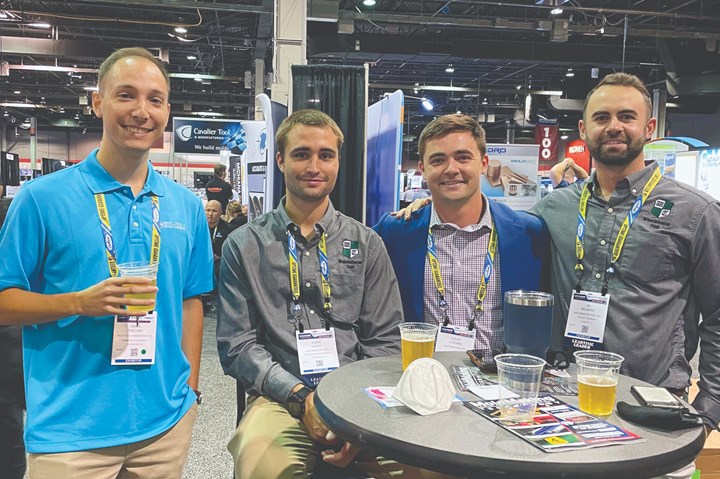
Some of MMT’s 2021 30 Under 30 honorees, representing the next generation of this industry, paid a visit during one of Amerimold’s happy hours.
What Tech Talk stood out to you the most? Why?
Christina Fuges: I put the program together, so I’ll pass on saying which presentation stood out to me. However, I do know that the two most well-attended were both focused on 3D printing (“Applying 3D Printing to Mold Venting” and “Discovering 3D-Printed Steel that Matches Conventional Tool Steel Performance”), so that tells me our industry is getting more serious about this technology and what it can do for them and their customers.
Grace Nehls: The CGS North America/CAMTool Tech Talk, “Using Automation to Help Solve the Skills Gap in Moldmaking” was very intriguing. This Tech Talk only served to emphasize how far automation has come, even for moldmakers; whether it’s new machining technology, tooling, toolholders or CAM software, there are so many opportunities to reduce what once was a time-consuming manual process into something that helps maximize time, product quality and accuracy.
After returning to in-person events, what are some benefits you’ve found with networking in person? Are there any drawbacks?
Christina Fuges: Absolutely no drawbacks from my perspective.
Grace Nehls: Amerimold being my very first trade show, it’s impossible to compare to past experiences. However, from my experience beginning my current position as print production editor remotely due to the pandemic, I can say that being able to meet and connect to individuals who I’ve only corresponded with over email was much more gratifying. It was also so much easier to get a grasp on the industry itself, particularly for someone who is starting from scratch; visuals, and the ability to ask someone as many questions as you’d like is something that remote working (and learning) can never compare to.
Anything important you took away from those you connected with?
Christina Fuges: We need to be in person. No virtual event can ever take the place of this community connecting in person to share, learn, teach, problem solve, celebrate, recruit, market… you name it!
Grace Nehls: As an editor, the most valuable lesson I took away is that everyone is willing to be a resource. We’re all human, and have feelings, opinions, strengths and weaknesses; when you’re corresponding with people you’ve never met solely through email, it’s easy to forget these things. It’s also easy to forget that even the experts had to start somewhere.
How do you expect networking to change, now that we’ve all experienced about a year working from home?
It was generally agreed between the MMT editors that, while there are some effective vehicles for making connections virtually (LinkedIn groups, for example), the best networking happens in person.
“I don’t think people will shy away from virtual meetings or working from home, but I do believe that the need for in-person networking is real and it works,” Grace notes. “There are so many ways to network now and the pandemic brought out evolved ways of communicating that we will likely keep using for years to come.”
Christina also reflected on the impact and meaning that seeing faces and expressions while shaking hands, sharing a meal, telling stories and swapping lessons learned in person has on people, and Grace emphasized that human beings are social creatures by nature. “I do believe there will be more flexibility—remote learning opportunities, in addition to in-person ones, for example, or even events that maintain a hybrid option (in person and online) to accommodate those who cannot attend fully—but networking face to face won’t ever go away completely.”
What kinds of technology/service offerings stood out to you on the show floor?
Christina Fuges: Better than what I think, is what attendees told me stood out to them (without naming names, of course). Many noted mold design software, mold components like vented ejector pins, collapsible cores and slide mechanisms, new additive mold materials, metal AM services and the Tool Room Live! demo that showcased a bunch of mold maintenance technologies.
Grace Nehls: Those booths that were able to demonstrate their technologies were very interesting to me, mostly because I had never been able to view anything in action before prior. Capture 3D’s ATOS 5 noncontact bluelight 3D scanner, for example, provided a visual from the scanned part, to how it appears on the screen. Similarly, Alliance demonstrated its 600-watt IDI fiber laser welder and CAE Services had an example of how its standalone vacuum venting system eliminates gas and air entrapment, just to name a few.
What is/are your favorite feature(s) of the show?
Christina Fuges: Hands down the annual Leadtime Leader Awards Ceremony. This Award is one of my career highlights. Being part of launching an Award that recognizes a leading mold builder every year and then getting to watch the community celebrate with them is what it is all about! To top it all off, this year’s ceremony was standing room only and the 2020 and 2021 winners put on a good show during the acceptance speech… both entertaining and heartfelt. Thanks, Precise Tooling Solutions and Westminster Tool! (Check out this quick video recap of the Awards speech and my conversation on the showfloor with LLA CFO Colby Coombs.)
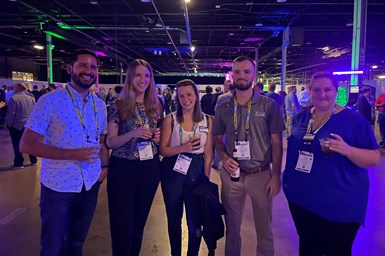
Print editor Grace hangs out with some new friends during the Lights Out party.
Christina’s favorite takeaways were also reflected in Grace’s answers. In addition to the Leadtime Leader Award, the happy hours and Lights Out event were also popular choices, particularly because they gave the opportunity to continue developing the relationships previously begun walking the show floor, but in a more relaxed setting. “Plus, it was nice to see others enjoying themselves again after this pandemic,” Grace notes.

Ray Coombs Jr., president of Westminster Tool and MMT Editorial Director Christina Fuges share the stage at the 2021 Leadtime Leader Awards.
How did this year’s show compare to past shows? What was the same? What was different?
Christina Fuges: Outside of slower than usual traffic, which was expected due to COVID-19’s impact, the show was the same. The phrase “quality over quantity” was said again and again, and to be quite honest that is what Amerimold was built upon. It is a targeted trade show with attendees and exhibitors coming to the event who need and want to be there… and no one else.
What was the most difficult aspect of your first Amerimold trade show?
Grace Nehls: The hardest part was gathering the courage to speak to people/get past the fear of sounding stupid. “How do I try and connect with these individuals if I’m not an expert?” was often something I internally asked myself on the show floor. Nevertheless, I realized that it didn’t matter—these moldmakers just wanted to get to know everyone and teach what they’re passionate about.
What do you think Amerimold did well? What do you hope to see the next time?
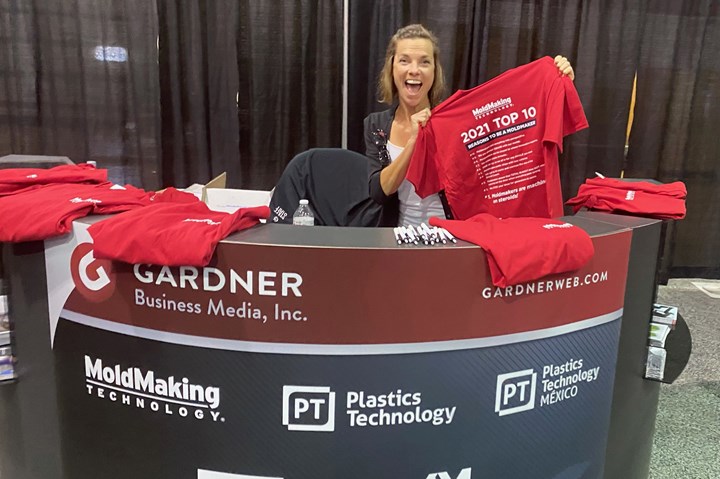
Can you tell Christina was excited for Amerimold?
Christina Fuges: Amerimold provided a home in which the mold manufacturing community could come back together in person after a long two years apart (see my brief recap). Next time, I hope to see more collaborative demos on the show floor incorporating machinery, software and molds.
Grace Nehls: The enthusiasm and positivity brought to Amerimold really made this trade show stand out, but attendance can improve. I’m hoping that more companies find the willingness to get back into in-person events.
What have you taken away from this Amerimold 2021?
It was agreed that it was good to be back to in-person trade shows, and both MMT editors are looking forward to reconnecting back in Rosemont March 29-31, 2022 for our inaugural Plastics Technology Expo (PTXPO) featuring the MoldMaking Pavilion powered by Amerimold and MoldMaking Technology where we will have free panel discussions on current trends and technologies, MMT Chats Live! broadcasts and a daily “moldmaking” card game competition to both entertain and educate.
Related Content
MoldMaking Technology's Leadtime Leader Awards Competition Returns!
After a brief hiatus, MoldMaking Technology’s Leadtime Leader Awards Competition is back!
Read MoreMore Than Moldmaking at PTXPO 2023
The Moldmaking Pavilion returns to the Plastics Technology Expo (PTXPO) March 28-30, 2023, at the Donald E. Stephens Convention Center in Rosemont, Illinois, but there’s more to discover than moldmaking.
Read MoreWhere Mold Manufacturing and Plastics Processing Connect
The Moldmaking Pavilion is one of seven pavilions returning to the show that houses exhibitors offering technology and service solutions for your specific moldmaking needs.
Read MoreMoldmaking, the Relentless Pursuit of Innovation … Oh Yeah!
Innovation was at the root of the presentation lineup for the 2023 MoldMaking Conference, which included a heavy focus on automation, collaboration and communication, as well as mold design, talent development, reshoring and sustainability.
Read MoreRead Next
Back Together Again at Amerimold 2021: Quality Conversations and Connections
The mold manufacturing community came together last week after a long two years apart, and it felt great! This slideshow is a very quick glimpse of everything from the show floor and technical presentations to the awards ceremony and networking party.
Read MoreReasons to Use Fiber Lasers for Mold Cleaning
Fiber lasers offer a simplicity, speed, control and portability, minimizing mold cleaning risks.
Read MoreAre You a Moldmaker Considering 3D Printing? Consider the 3D Printing Workshop at NPE2024
Presentations will cover 3D printing for mold tooling, material innovation, product development, bridge production and full-scale, high-volume additive manufacturing.
Read More















